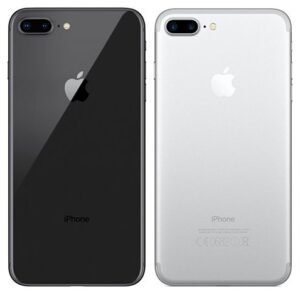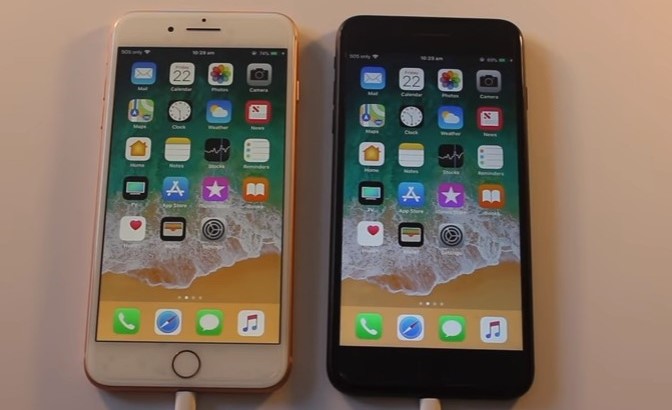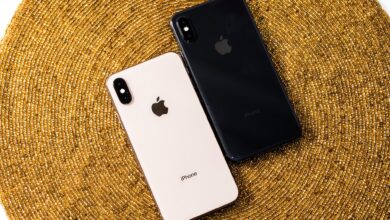
The iPhone 8 Plus and iPhone 7 Plus may have been in the market for a while now, and since Apple still provides software updates for them, they are the perfect candidates for budget refurbished phones. Most new iPhones come with eye-watering price tags, and the options are only limited to whatever has been released that year, in this case, the iPhone 12. In any case, if your needs don’t demand the latest iPhone in the market, there are plenty of options you can choose from, and best of all, the prices are flexible. The iPhone 8 Plus and iPhone 7 Plus are great options, but they aren’t dramatically different. There are various reasons to buy each of them so let’s dive in and see what they are.
iPhone 8 Plus vs. iPhone 7 Plus: The Similarities.

While on paper they are essentially two different generations of iPhones, iPhone 8 Plus and iPhone Plus are broadly similar in design. Each features a large 5.5-inch Retina IPS LCD with huge bezels on the top and bottom. The 1080 x 1920 pixels displays are also alike, reaching 625 nits (typ) brightness and 401 PPI density. The displays’ technical specs are similar and feature a 1300:1 contrast ratio, wide colour gamut, and 3D touch. The iPhone 8 Plus, however, uses Apple’s TrueTone display technology which automatically adjusts the colours and the colour intensity to match that of the ambient environment. For example, if the day is cloudy, your display will show cooler colour tones, and in the presence of warm light, the display shows warmer tones. Both have a home button that houses the fingerprint scanner; therefore, TouchID is their primary security feature.
That’s not all. The iPhone 8 Plus and iPhone 7 Plus both have a dual-camera setup comprising 12 MP, f/1.8 main, and 12 MP, f/2.8 telephoto lenses. Each camera has HDR functionality, but while the iPhone 7 Plus cameras can only shoot 4K video at 30fps, the iPhone 8 plus can shoot 4K video at 60fps. The front camera units—7 MP, f/2.2, are also similar, with both shooting 1080P video at 30fps. That aside, both phones are IP67 rated for splash, sweat, water, and dust resistance, and both use a lightning connector for charging and data transfer.
iPhone 8 Plus Vs. iPhone 7 Plus: The Differences.
 While they may have similarities, there’s a reason why they are different model phones. Starting with the design and straight away, you will notice that the iPhone 8 Plus has a glass back compared to the metal case of the iPhone 7 plus. This glass back allows for Qi wireless charging on the iPhone 8 Plus. The iPhone 8 Plus has the added advantage of 15W fast charging, which means 50% charge on 30 minutes of charging.
While they may have similarities, there’s a reason why they are different model phones. Starting with the design and straight away, you will notice that the iPhone 8 Plus has a glass back compared to the metal case of the iPhone 7 plus. This glass back allows for Qi wireless charging on the iPhone 8 Plus. The iPhone 8 Plus has the added advantage of 15W fast charging, which means 50% charge on 30 minutes of charging.
The iPhone 8 Plus uses Apple’s A11 Bionic chip, while the iPhone 7 Plus has the A10 Fusion. This brings out the performance gap between the two phones. The A11 Bionic chip has two performance cores that are 25% faster than before and four high-efficiency processor cores that are 70% faster than those of the iPhone 7. This is a difference you will notice in some aspects when using the phones. The graphical A11 Bionic chips also give the iPhone 8 Plus a 30% boost in graphical performance. Even with the A10 Fusion chip, the iPhone 7 Plus is still a mighty fast phone, and for regular use, the differences with the A11 Bionic are negligible.
While both phones have 3GB RAM, internal storage options for the iPhone 7 Plus are 32GB, 64GB, 128GB, and 256GB, while the iPhone 8 Plus only begins at 64GB to 256GB. Thanks to the improved processor, iPhone 8 uses Bluetooth 5.0 in contrast to the Bluetooth 4.2 of the iPhone 7 Plus. This translates to faster pairing, better connection, and range.
To sum up, the iPhone 8 Plus works like a higher spec iPhone 7 Plus, but each of them is fit for different people. Their designs are similar, and the iPhone 8 Plus does what the iPhone 7 Plus does, albeit more conveniently and faster thanks to the A11 Bionic chip. The glass back that allows wireless charging on the iPhone 8 Plus is an excellent addition, especially with the recent release of MagSafe accessories—they are exclusive to iPhone 12. Both Phones will easily get updates to the latest iOS releases making them great options for refurbs. From their release in 2016 for iPhone 7 plus and 2017 for iPhone 8 Plus, they have proven themselves as reliable devices, and the option to get one at a great value is worth the investment.





